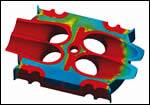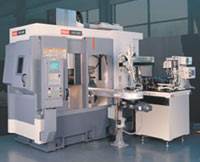Cleaning Molds: Part II
Even though hand cleaning will never be completely eliminated, ice blasting is an alternative cleaning method that can effectively reduce cleaning time and cost.
The most commonly used method for cleaning plastic injection molds today remains the somewhat antiquated process of scrubbing tooling and plates, one piece at a time. Ask why, and the answers will probably be:
- "This is the way we've always done it."
- "We can't cost-justify other methods."
- "Other methods don't clean as well, they don't leave a bright and shiny surface."
- "We're too busy. We don't have time to experiment with or investigate other methods."
These excuses can cost companies thousands of dollars a day in wasted time and worn tooling.
To realize a major reduction in the time required to clean molds, to maximize tooling life, to systemize cleaning and make it more consistent and predictable, more modern methods should be introduced in the mold shop, and hand cleaning should be limited to the areas where it works the best and damages the least.
Hand Cleaning
It is a safe bet that hand cleaning will never be completely eliminated, but it is an enormous waste of time and money to remove, clean, rinse, dry and replace every piece of tooling contained in a mold whenever it needs to be cleaned.
Hand cleaning tooling is a slow and damaging process. It is an effective cleaning method, however, for areas of plastic molds that normally have the most corrosion and contaminant build-up (rust), including:
- front and rear clamp plates that directly contact the press platens
- bubbler plates (non-stainless)
- bushings and wear plate grease grooves
- water lines (non-stainless) with heavy build-up
- plates subjected to heavy internal condensation and clamp pressure (non-stainless)
Managerial inertia sometimes leads a shop to keep using old, familiar (and ineffective) methods rather than deal with the mayhem that a change in cleaning culture can cause. Choosing the wrong type of cleaning system or having repair technicians reject the new method can cause disastrous repercussions, so they avoid making a change. I spent many years during my career hand cleaning my own plates and tooling (and being pushed to "hurry up") while the company leisurely searched for effective alternatives. We experimented with different types of spray cleaners, solvents and brushes, but they all required handling each piece of tooling several times, so none resulted in significant savings in cost or labor. Even extremely caustic cleaners, such as sodium hydroxide, sulfuric acid baths or MEK, were limited in the amount of rust build-up they would remove on unplated surfaces in a specific time frame. In the end, I found that the answer to heavy rust build-up is prevention—through more frequent cleanings, use of stainless steel plates and corrosion-resistant platings, and consistent application of spray-on rust inhibitors.
Cleaning Systems—CO2 Dry Ice Pellet Blasting
There is an almost endless variety of resins, molds and processes available today, so there is no silver bullet that is effective against all the types of mold fouling and corrosion that attack molds, whether running or racked. An ice blasting cleaning system, however, is a very effective method.
Ice blasting is a non-abrasive cleaning method that first became popular among automotive rubber molders because of its ability to clean molds in the press, while the mold is hot, without causing an appreciable secondary waste stream of its own. Solid carbon dioxide pellets (about the size of a grain of rice) or shavings (about the size of a grain of sugar) are introduced into an air stream and are shot out at high velocity through a variety of state-of-the-art, aerodynamically designed nozzles to remove residue quickly and harmlessly from mold plates and tooling.
Two types of systems are used in ice blasting:
- Venturi (double-line hose) system—pulls or vacuums shaved ice particles into the air stream at the nozzle that is then directed toward the contaminated surface. This system is less costly than the single-line hose, but does not generate the nozzle velocities necessary to remove some of the more stubborn residue and grime left through the molding process of plastic molds.
- Direct acceleration (single-line hose) system—introduces larger ice pellets into the airline at the hopper instead of the nozzle, allowing for much faster moving pellets exiting the nozzle tip (900 feet per second versus 300 for the double line), which translates to better cleaning performance. If less cleaning power is needed, the air pressure is simply dialed down, reducing pellet velocity.
Pros of Dry Ice Pellet Blasting
- Non-abrasive—Ice blasting is not abrasive to all tool steels and hardened aluminum, even over extended periods. Molds can be ice blasted several times per shift with no damage to parting lines, applied platings or surface finishes. The technique works well on textured and polished cavity surfaces.
- Clean operation—Ice blasting is the only media blasting that does not produce residual dust or waste stream through its own operation. Air quality tests performed in cleanroom operations using ice blasting showed no measurable effects from the disintegration of the carbon pellets. Residue blasted off the surface of the mold may collect on surrounding equipment over a period of weeks or months, but air extraction hoods can be installed over the molds that generate heavy contamination to alleviate the problem.
- Portability—Small, lightweight ice blasting units are available that can be pushed up alongside a mold on the bench or in the press, which is consideraby less expensive than bringing the mold to the cleaner. Keep in mind that an air supply will be needed close by (20 feet) to tap into. Standard line pressures of 70 to 90 psi with a 3/4 feed line will suffice.
- Versatile—Ice blasting can be used to clean molding equipment other than molds. It is also effective for cleaning press screws, barrels, internal mixers and other equipment.
- Low operating cost—Ice pellets for single line systems cost about 20 cents per pound. It takes approximately 20 minutes to use 30 pounds of ice pellets, which is approximately the time it takes to clean both halves of a plastic mold measuring 2 feet by 3 feet. Plan on spending at least $15,000 for a single-line portable unit and a couple of different nozzles.
- Ease of use—It takes just a few minutes to become familiar with procedures for hooking up the hoses and nozzle and loading the pellets. Not having to be concerned about abrasiveness eliminates the fear of surface degradation from moving the nozzle too slowly.
Cons of Dry Ice Pellet Blasting
- Noise level—At approximatley 102 decibels, good ear protection is required when ice blasting, as when using any compressed air cleaning system. However, even with earplugs, ice blasters are are loud and the noise grows more irritating when used for extended periods. It helps to use earmuffs with earplugs.
- Mold safety—Mold plates can blow over and tooling can be launched from bores if proper precautions are not taken, or if the the nozzle tip is misdirected. Plates must be securely braced or laid down and tooling must be backed up or secured. Do not stack tooling in a basket and start blasting.
- Personnel safety—As hunting dads say, "Watch where you point that thing, son." Human flesh is no match for ice pellets moving at 900 feet per second. In addition to ear protection, required safety equipment includes heavy-duty gloves, full face mask, long sleeves, etc. Typical workshops are set up with benches and other machines in close proximity (three to five feet), so the operator must be aware at all times where others are located, or risk being accused of violating good shop etiquette through unsolicited exfoliation.
- Rust/residue removal—The non-abrasive nature of ice blasting limits its effectiveness for heavy stain and rust removal. Ice pellets also can bounce off elastic or soft residues left in some natural rubber molding operations. Ice blasters are a line-of-sight cleaning system—you can clean only what you can see.
Ice blasting is best used as an in-press cleaning system where it can reduce cleaning time and eliminate the premature tooling wear that results from a typical solvent-soaked rag and abrasive pad wipedown method. It is especially effective for removing liquid silicone rubber plate-out and for cleaning tooling with textured surfaces. Our 32-cavity, quarter cap mold receives an in-press ice blasting every seven days throughout its production run, cutting the cleaning time required for the next phase of residue removal... the ultrasonic bath.
Related Content
The Ins and Outs of Hot Runner Temperature Control
A training checklist that explains the why and how of proper hot runner temperature control and system management.
Read MoreWhat You Should Know About Injection Mold Safety Straps
Every mold should have one in order to be safe and OSHA compliant.
Read MorePortable Low-Heat, Non-Arcing Resistance Welder for Mold Repair
Rocklin’s user-friendly MoldMender Micro Welder delivers simple and cost-effective localized repair in-house with precision and versatility, enhancing mold and die durability and reducing disassembly and downtime.
Read MoreWhat is Scientific Maintenance? Part 2
Part two of this three-part series explains specific data that toolrooms must collect, analyze and use to truly advance to a scientific maintenance culture where you can measure real data and drive decisions.
Read MoreRead Next
Cleaning Molds: Part III
Ultrasonic immersion cleaning is a non-abrasive, user-friendly method that has the greatest impact on reducing cleaning time, improving mold cleaning consistency and reducing tooling damage.
Read MoreCleaning Molds: Part I
Cleaning a mold is a critical part of the repair process, but many myths must be dispelled.
Read MoreHow to Use Strategic Planning Tools, Data to Manage the Human Side of Business
Q&A with Marion Wells, MMT EAB member and founder of Human Asset Management.
Read More












.jpg;maxWidth=300;quality=90)








.jpg;maxWidth=970;quality=90)